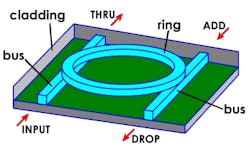U. of Sydney researchers unveil mode-locked laser based on microcavity resonator
Sydney, Australia--A group at the University of Sydney and its international collaborators has created the first mode-locked laser with a microring resonator as its cavity.1 The laser, which emits pulses at rates as high as 200 GHz with a spectral linewidth well under 130 kHz, operates via a new form of mode-locking that the researchers call "filter-driven four-wave mixing."
The team also includes researchers from INRS-EMT (Varennes Québec, Canada), IPCF-CNR, UOS Roma, and ISC-CNR UOS Montelibretti, ( Rome, Italy), Infinera (Sunnyvale, CA), and the City University of Hong Kong.
CMOS compatible
One great advantage of some integrated photonics is that they are CMOS-compatible, meaning that they can be fabricated using the same inexpensive, large-scale processes used to fabricate computer chips. The U. of Sydney laser falls into this category.
The microring laser's cavity modes are phase-locked, which, via the resulting frequency combs, could lead to new optical clocks for metrology, integrated photonics, and communications.
REFERENCE:
1. M. Peccianti et al., Nature Communications 4, article no. 765, April 3, 2012.

John Wallace | Senior Technical Editor (1998-2022)
John Wallace was with Laser Focus World for nearly 25 years, retiring in late June 2022. He obtained a bachelor's degree in mechanical engineering and physics at Rutgers University and a master's in optical engineering at the University of Rochester. Before becoming an editor, John worked as an engineer at RCA, Exxon, Eastman Kodak, and GCA Corporation.
